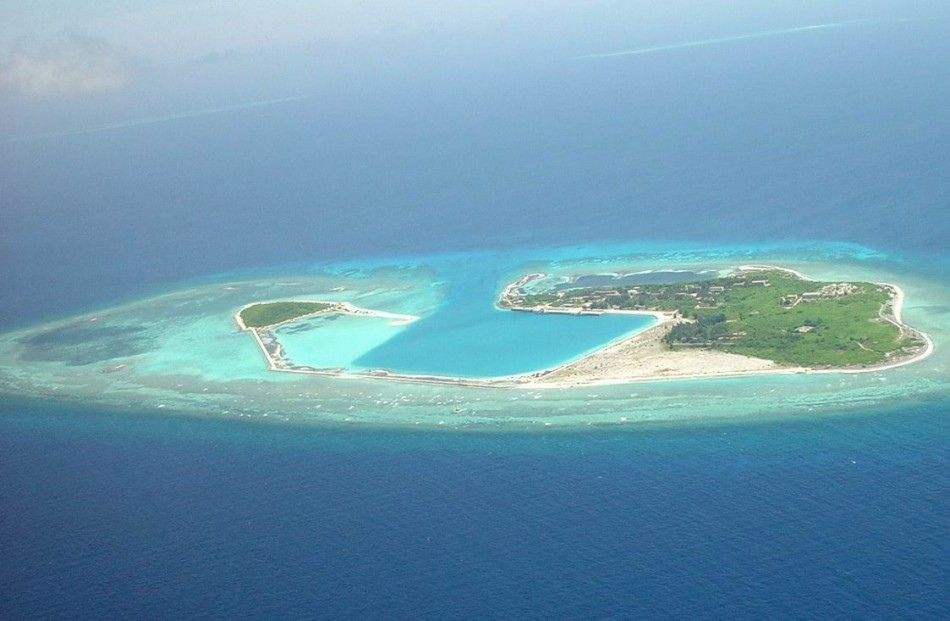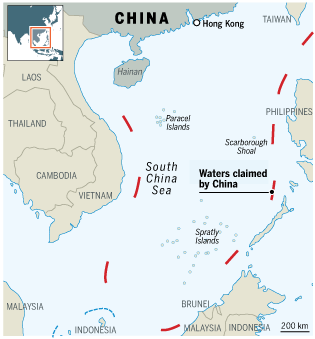China’s Problem With Rules: Managing A Reluctant Stakeholder

Many admonish the United States for not finding a more far-sighted way to manage strategic competition with a reemerging China. However, the ongoing search for a bilateral strategic roadmap has proven quixotic largely because of China’s reluctance to embrace international norms and rules, especially in the realm of national security. From maritime disputes to economic cyber theft, China is keen to exert its newfound power rather than to be bound by multilateral rules. Meanwhile, the ongoing crackdown on domestic freedom in China only reinforces fears that Beijing will treat neighbors as subordinates and remain a reluctant global stakeholder for decades to come.
Major General Zhu Chenghu recently claimed that “the Americans are making very, very important strategic mistakes right now” in their dealing with China. “If you take China as an enemy,” he expanded, “China will absolutely become the enemy of the U.S.” But while General Zhu seeks to defend Chinese coercion through punchy talking points, he glosses over China’s role in determining the fate of regional peace. As Joseph Nye is fond of saying, “only China can contain China,” because neighbors will respond to the tenor of Chinese behavior.
Far from seeking to create a new Cold War in Asia or contain China, the United States wants to see the amazing development and dynamism of Asian economies continue. But this will require continued consensus on certain rules, which is challenging in no small part because China apparently does not want to buy into the post-World War II international system that it did not play a role in creating. Yet China claims that it wants to play a responsible role and that it wants to create rules. From the Shanghai Cooperation Organization and an Asian infrastructure bank, to proprietary dialogues with Southeast Asia and both Koreas, China wants to be “present at the creation.” In short, China wants to make rules that are mindful of Beijing’s point of view if not Sinocentric.
The current U.S. strategy for managing a rising China rests on a three-legged stool of engaging, binding, and balancing. The essential goal of this strategy is to integrate an increasingly powerful China into an international system largely crafted by the United States. The overt aim is to coopt China over time into becoming a responsible stakeholder in world affairs, recognizing that a partnership with China will necessarily force some adjustments to the international order. While we undertake this long-term project, we must hedge against the possibility that China finds it more convenient to resort to arbitrary aggression rather than follow agreed-to norms.
America’s approach to China
Properly resourced and executed, the American approach of engaging, binding and balancing will be agile and durable. It should place greater weight on primary information rather than mirror-imaging assumption, rules rather than vague commitments to pursue win-win cooperation, and defensive pressure in the form of U.S. and regional capability rather than vapid diplomatic blandishments unsupported by the strong backbone of military potential. The emphasis placed on each leg of the stool should be based on the context.
Critics of this multi-dimensional approach often advocate a singular method of dealing with China. However, the monistic theories put forward are inherently less stable than the three-legged stool. Engagement alone will not necessarily remove distrust but may also more readily reveal clear conflicts of interest. Binding works better on matters of commerce than on national security. And solely relying on balancing would have unintended consequences, either by creating a self-fulfilling prophecy (a hostile China) or by unleashing other regional dynamics that threaten wider conflict.
But is it working?
Nonetheless, a cardinal strategic challenge is what to do about a more confident China’s desire to restore its historic position and control over the region. China is unrelentingly assertive about its claims in its near seas as it seeks to flex its muscle and gain greater de facto and de jure control of the East and South China Seas. Although tensions with Japan are serious, in some ways China seems more determined to control the South China Sea, to provide greater operational maneuver for its major submarine base in Hainan, exploit resources, and control sea lines of communication. And who, China appears to be asking, can prevent it from taking incremental steps to achieve greater control?
Having made an argument in favor of the current U.S. policy framework for dealing with China (if not necessarily U.S. policy implementation), adjustments should be made in response to the lack of progress thus far. China’s recent behavior in its near seas provides demonstrable evidence of the difficulty China is having in accepting U.S. and international rules. China espouses good relations with its neighbors, and yet State Councilor Yang Jiechi’s visit last week to Hanoi appeared intended to scold the Vietnamese rather than to defuse the crisis begun in early May after China placed an oil rig off Vietnam’s coast and close to the disputed Paracel Islands. Councilor Yang complained about Vietnam’s “illegal disruptions.”
But what is clearly illegal is China’s insistence that the rig, though not in China’s territorial waters, is entitled to at least a 3-nautical mile defensive perimeter. It is using naval, cost guard, and fishing vessels to patrol at least that distance around the deep-sea drilling platform HS-981. Yet under the United Nations Convention on the Law of the Sea (UNCLOS), the only way China would be permitted more than a 500-meter safety zone is if the rig were in China’s territorial waters. If China is actually claiming that the rig is sitting in its territorial waters, then it is effectively claiming the right to own an expansive 9-dashed line area of claim on the South China Sea. The dashes were drawn up under Chiang Kai-shek before the creation of the People’s Republic of China and purport to show the general area over which China has held historical suzerainty. Of course, the specific concept of sovereignty did not emerge until the 1648 Peace of Westphalia, and claims of “historical rights” have no basis in UNCLOS, which is considered the “constitution for the oceans.” In short, China is acting unilaterally to change the status quo through coercion. And a region in which China’s historical claims trump international law and the rightful claims of others is a region heading for trouble.

Tensions with Vietnam have spiked in the past few months. Recently released photographs taken in March show China’s reclamation of Johnson South Reef in the disputed Spratly Islands. Johnson South Reef was also the site of a Vietnam-China naval skirmish in March 1988. During the standoff between Beijing and Hanoi over the former’s new oil rig, its vessels rammed and sunk a Vietnamese fishing boat (which I inspected in Danang this past weekend) and a coast guard vessel. A second oil rig has been maneuvering close to Vietnam, but as of this writing remains on the Chinese side of the median line and thus does not pose the same challenge to Vietnamese sovereignty as the HS-981 oil rig.

These actions in the South China Sea mirror similarly brazen moves—to include close-in buzzing of Japanese patrol aircraft by PLA fighters on two occasions since May–in the East China Sea and are part of a deliberate policy calculus in Beijing. While China may not be expanding its historic claims, it is employing tailored coercion as a means of strengthening its physical and legal control.
Can China be a rule maker?
This maritime assertiveness begs the question as to what it means to be a rule maker. The United States assumes great responsibility as a rule maker and therefore follows three facets of the rule of law: predictability or reliability, transparency, and a sense of fair play or fairness. But, judging by China’s recent behavior, predictability, transparency and fairness do not seem to be Chinese objectives.
Even allowing for an inchoate decision-making process, Chinese leaders generally value other goals more than the goal of enhanced international predictability. China’s about-face in dealing with Vietnam over the past nine months is a case in point: last October Premier Li Keqiang visited Vietnam to shore up closer relations; then in early May China inexplicably stirred up a fight by placing its oil rig inside Vietnam’s exclusive economic zone. To the extent China is fixated on the international environment, it is reflected in its periphery diplomacy—the desire to stabilize, tranquilize and monopolize the ring of 14 countries surrounding the world’s most populous country.
Similarly, Chinese leaders often see transparency as undermining China’s authority and core interests. For instance, a documentary whose production was supervised by the China’s National Defense University emerged briefly on the Internet last October. The 100-minute video, called “Silent Contest,” argues that China’s openness to the Western values and culture makes it susceptible to a subversive poison pill.
Chinese leaders tend to see fairness through the prism of their own historical experience and understanding (others made rules for China to follow). One can find a narrative for many arguments here. In his book, Contingent States: Greater China and Transnational Relations, William Callahan considers four Chinese narratives: (1) defense (a “Great Wall” territorial state); (2) conquest (constantly enlarging, from subduing barbarians on its borders to restoring “lost territories” and reversing the “century of humiliation”); (3) conversion (defining and spreading the characteristics of Chinese civilization, not simply soft power but the belief in the inherent superiority of Chinese civilization); and (4) identity (linking Chinese identity to its diaspora).
China is allergic to compromise when it comes to security issues. After all, China is largely a rule-abiding nation and it generally seeks to make its argument on the basis of what it perceives to be legal and historical rights; it’s the potential exceptions, such as the recent pattern of incidents in the East and South China Seas, that garner the most attention. When it comes to hard security issues, sovereignty and “core national interests” tend to trump a desire to demonstrate cooperation.
The nine-dash line in the South China Sea is a case in point: some Chinese scholars will privately offer reassuring interpretations of what is intended by it, but other scholars and even officials are much less accommodating. Officially, China refuses to clarify whether this claim is based on land features, which might give the claim a firmer basis in international law. This harkens back to the problem of predictability: without a fixed, defensible position, China’s murky claims appear blatantly counter to internationally acceptable rule making.
Dealing with China’s approach to the region
Chinese leaders hold fast to a sense of major power entitlement. They prefer bilateral agreements that obligate smaller neighbors and avoid anything that might constrain them. Thus, China has struck accords with Vietnam but it has also been more aggressive in seeking to squeeze the Philippines, for example muscling the Philippines out of Scarborough Reef in 2012 (and maintaining a Chinese presence ever since), and impeding the ability of the Philippines to resupply the grounded naval ship BRP Sierra Madre near Second Thomas Shoal. The reclamation of Johnson South Reef and other reefs in the Spratly Islands is another Chinese assertion of power in general, if not also a way to register dissatisfaction with recent steps by neighbors to strengthen their security posture in particular. While China has long had plans to deploy oil rigs near the Paracel Islands, the timing of the deployment comes in the immediate aftermath of a successful summit meeting in which President Obama and Philippine President Benigno Aquino signed an Enhanced Defense Cooperation Agreement permitting US military access over the next decade.
Since conflicting maritime claims are not likely to be settled soon, they must be managed, including through confidence-building measures to avert escalation. Unfortunately, China has shown little willingness to sign up to binding confidence-building measures. China resists restrictions on its ability to press its claims, expand its influence, and preserve its future options. In the East China Sea, China is unlikely to implement even a previously agreed crisis-management mechanism negotiated in the wake of the September 2010 incident involving a Chinese fishing trawler captain who rammed two Japanese Coast Guard vessels; China appears to be holding up such cooperation unless Japan gives up its claim to uncontested sovereignty over the Senkaku Islands. China wants geographical space but it also wants more influence and respect. As with the South China Sea, tensions in the East China Sea are likely to remain high, especially after President Obama has in the eyes of many Chinese failed to treat China as an equal in the enterprise of Pacific maritime security.
China is a joiner of multilateral dialogue, but a practitioner of bilateral diplomacy. It prefers multilateral dialogue to agreement and if there must be agreement then it should have ample escape clauses. This has been the case with China’s nominal support for a Code of Conduct. A Declaration on the Conduct of Parties in the South China Sea was signed in 2002, and yet still there is no binding Code of Conduct. Moreover, it is unlikely to be accepted by China anytime soon. China takes a dim view of to the 10-member Association of Southeast Asian Nations (ASEAN), particularly when it involves maritime tensions with China. For China, ASEAN unity is a sandcastle: kick it and it will dissolve.
China also touts the fact that it recently signed a Code for Unplanned Encounters at Sea at the recent Western Pacific Naval Symposium held in Qingdao. CUES is meant to help avoid accidents at sea. However, the code is voluntary and applies only when naval ships and aircraft meet “casually or unexpectedly.” It also does not apply to a country’s territorial waters, and of course countering China’s expansive claims to territorial waters is one of the most pressing problems in the South and East China Seas. “It’s recommended, not legally binding,” PLA Navy Captain Ren Xiaofen made clear after the symposium.
The troubled waters of both the East and South China Seas are apt to remain that way in the period ahead. In the East China Sea, we can expect more military and coast guard maneuvers and the deployment of new technologies for surveillance. In the South China Sea, we can expect China to draw from a list of assertive moves in the coming year: more control over resources; more reclamation of submerged features to build artificial islands; more propaganda based on domestic legal and historical narratives; and quite possibly a new Air Defense Identification Zone to mirror the one announced in the East China Sea last November.
China is emphatically using more coercive means, loosely adhering to broad international principles, to change facts on the ground and in adjacent seas. But rather than rule making, China is resorting to rules as instrumental to its hard-power goals of restoring old claims and lost territories. The burgeoning “rights” advocates in China further impel Xi Jinping and other Chinese leaders to remain uncompromising on issues perceived as related to China’s sovereignty.
A question we cannot afford to get wrong
Anyone watching Chinese foreign policy should remember that China is consumed with internal order questions and far less concerned with global order than is the United States. Some have argued that the United States’ capacity for—if not interest in– supporting global order is dissipating. If that perception spreads, anyone invested in the current global order should be worried because it invites rule breaking by regional powers that may assume there will be no one around to enforce those rules. Although two data points do not equal a trend, Syria’s use of chemical weapons and Russia’s annexation of Crimea would appear to be illustrative of the kind of incidents these days that are calling into question who makes and enforces the rules. The growing crisis in Iraq may well pose a third test of international cooperation.
China has increasingly been a joiner of international bodies rather than a strong rule-maker, and when it has sought to make rules it has often been in the company of like-minded emerging or regional powers. But without more predictability, transparency and fairness with respect to international rules, China’s attempts to play a larger role as a rule maker— rather than simply biding time while developing as had been the longstanding dictum since Deng Xiaoping’s time—will fail to attract serious support.
In short, China as a rising great power will not wish to lock in constraints that will slow down its power as it reemerges. China is a partial rule maker and partial rule breaker. But when it comes to hard security, it finds binding multilateral rules difficult to swallow. Instead, China uses rules as part of its three-warfares campaign to constrain smaller and larger neighbors alike while forestalling restrictions on an emerging China.
We cannot afford to get the China question wrong. After all, we are grappling with a vital geopolitical question: whether a rising and an enduring great power will be able to cooperate and manage competition without resorting to war in the twenty-first century. Perhaps no strategy will be determinative. And perhaps no strategy will permeate the impregnable forces of a self-confident 5,000-year-old civilization. But only a vigorous, persistent and agile implementation of engagement, binding and balancing can help to preserve security and build an evolving regional and global order.
Dr. Patrick M. Cronin is Senior Advisor and Senior Director of the Asia-Pacific Security Program at the Center for a New American Security, a bipartisan and nongovernmental think tank in Washington, D.C.

